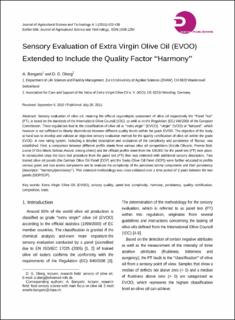Please use this identifier to cite or link to this item:
https://doi.org/10.21256/zhaw-1864| Publication type: | Article in scientific journal |
| Type of review: | Not specified |
| Title: | Sensory evaluation of Extra Virgin Olive Oil (EVOO) extended to include the quality factor "harmony" |
| Authors: | Bongartz, Annette Oberg, D. G. |
| DOI: | 10.21256/zhaw-1864 |
| Published in: | Journal of Agricultural Science and Technology |
| Page(s): | 422 |
| Pages to: | 435 |
| Issue Date: | 20-Jul-2011 |
| Publisher / Ed. Institution: | David Publishing |
| ISSN: | 1939-1250 |
| Language: | English |
| Subjects: | Sensory quality; Paneltest; Extra virgin olive oil (evoo); Harmony |
| Subject (DDC): | 664: Food technology |
| Abstract: | Sensory evaluation of olive oil, meaning the official organoleptic assessment of olive oil respectively the "Panel Test" (PT), is based on the standards of the International Olive Council (IOC), as well as on the Regulation (EC) 640/2008 of the European Commission. These regulations lead to the classification of olive oil as "extra virgin" (EVOO), "virgin" (VOO) or "lampant", which however is not sufficient to clearly discriminate between different quality levels within the grade EVOO. The objective of the study at hand was to develop and validate an objective sensory evaluation method for the quality certification of olive oil within the grade EVOO. A new rating system, including a detailed description and evaluation of the complexity and persistence of flavour, was established. First, a comparison between different profile sheets from various olive oil competitions (Ercole Olivario, Premio Biol, Leone D'Oro Mario Solinas Award, among others) and the official profile sheet from the IOC/EC for the panel test (PT) took place. In consecutive steps the basic test procedure from the panel test (PT) then was extended with additional sensory descriptors. Two trained olive oil panels (the German Olive Oil Panel (DOP) and the Swiss Olive Oil Panel (SOP)) were further educated to profile various green and ripe aroma components and to evaluate the complexity of the perceived aroma components and their persistency (descriptor: "harmony/persistency"). This extended methodology was cross-validated over a time period of 3 years between the two panels (DOP/SOP). |
| URI: | https://digitalcollection.zhaw.ch/handle/11475/4260 |
| Fulltext version: | Published version |
| License (according to publishing contract): | Licence according to publishing contract |
| Departement: | Life Sciences and Facility Management |
| Organisational Unit: | Institute of Food and Beverage Innovation (ILGI) |
| Appears in collections: | Publikationen Life Sciences und Facility Management |
Files in This Item:
| File | Description | Size | Format | |
|---|---|---|---|---|
| 2011_Bongartz_Sensory_Evaluation_of_EVOO.pdf | 146.51 kB | Adobe PDF |  View/Open |
Show full item record
Bongartz, A., & Oberg, D. G. (2011). Sensory evaluation of Extra Virgin Olive Oil (EVOO) extended to include the quality factor “harmony”. Journal of Agricultural Science and Technology, 422–435. https://doi.org/10.21256/zhaw-1864
Bongartz, A. and Oberg, D.G. (2011) ‘Sensory evaluation of Extra Virgin Olive Oil (EVOO) extended to include the quality factor ‘harmony’’, Journal of Agricultural Science and Technology, pp. 422–435. Available at: https://doi.org/10.21256/zhaw-1864.
A. Bongartz and D. G. Oberg, “Sensory evaluation of Extra Virgin Olive Oil (EVOO) extended to include the quality factor “harmony”,” Journal of Agricultural Science and Technology, pp. 422–435, Jul. 2011, doi: 10.21256/zhaw-1864.
BONGARTZ, Annette und D. G. OBERG, 2011. Sensory evaluation of Extra Virgin Olive Oil (EVOO) extended to include the quality factor „harmony“. Journal of Agricultural Science and Technology. 20 Juli 2011. S. 422–435. DOI 10.21256/zhaw-1864
Bongartz, Annette, and D. G. Oberg. 2011. “Sensory Evaluation of Extra Virgin Olive Oil (EVOO) Extended to Include the Quality Factor “Harmony”.” Journal of Agricultural Science and Technology, July, 422–35. https://doi.org/10.21256/zhaw-1864.
Bongartz, Annette, and D. G. Oberg. “Sensory Evaluation of Extra Virgin Olive Oil (EVOO) Extended to Include the Quality Factor “Harmony”.” Journal of Agricultural Science and Technology, July 2011, pp. 422–35, https://doi.org/10.21256/zhaw-1864.
Items in DSpace are protected by copyright, with all rights reserved, unless otherwise indicated.